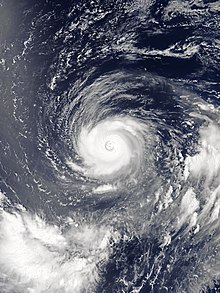 Noru at peak intensity south of Iwo Jima on July 31 | |
| Meteorological history | |
|---|---|
| Formed | July 19, 2017 |
| Extratropical | August 8, 2017 |
| Dissipated | August 9, 2017 |
| Duration | 2 weeks and 6 days |
| Very strong typhoon | |
| 10-minute sustained (JMA) | |
| Highest winds | 175 km/h (110 mph) |
| Lowest pressure | 935 hPa (mbar); 27.61 inHg |
| Category 4-equivalent super typhoon | |
| 1-minute sustained (SSHWS/JTWC) | |
| Highest winds | 250 km/h (155 mph) |
| Lowest pressure | 922 hPa (mbar); 27.23 inHg |
| Overall effects | |
| Fatalities | 2 |
| Damage | $100 million (2017 USD) |
| Areas affected | Japan |
| IBTrACS | |
Part of the 2017 Pacific typhoon season | |
Typhoon Noru was the second-longest-lasting tropical cyclone of the Northwest Pacific Ocean on record—behind only 1986's Wayne and tied with 1972's Rita—and the second-most-intense tropical cyclone of the basin in 2017, tied with Talim.[nb 1][1][2] Forming as the fifth named storm of the annual typhoon season on July 20, Noru further intensified into the first typhoon of the year on July 23. However, Noru began to interact with nearby Tropical Storm Kulap on July 24, executing a counterclockwise loop southeast of Japan. Weakening to a severe tropical storm on July 28, Noru began to restrengthen as it turned sharply to the west on July 30. Amid favorable conditions, Noru rapidly intensified into the season's first super typhoon, and reached peak intensity with annular characteristics on July 31. In early August, Noru underwent a gradual weakening trend while curving northwestwards and then northwards. After stalling off the Satsunan Islands weakening to a severe tropical storm again on August 5, the system began to accelerate northeastwards towards the Kansai region of Japan, making landfall in Wakayama Prefecture on August 7. Noru became extratropical over the Sea of Japan on August 8, and dissipated one day later.
Noru was responsible for two deaths in Kagoshima Prefecture, and at least $100 million (2017 USD) in damages in Japan.[3]
Cite error: There are <ref group=nb> tags on this page, but the references will not show without a {{reflist|group=nb}} template (see the help page).
- ^ "長寿台風 (統計期間:1951年~2017年第12号まで)" (in Japanese). Japan Meteorological Agency. Retrieved October 6, 2017.
- ^ Kitamoto, Asanobu. "Typhoon List by Track Information". Digital Typhoon. Retrieved August 8, 2017.
- ^ Cite error: The named reference
Global Catastrophe Recap August 2017was invoked but never defined (see the help page).